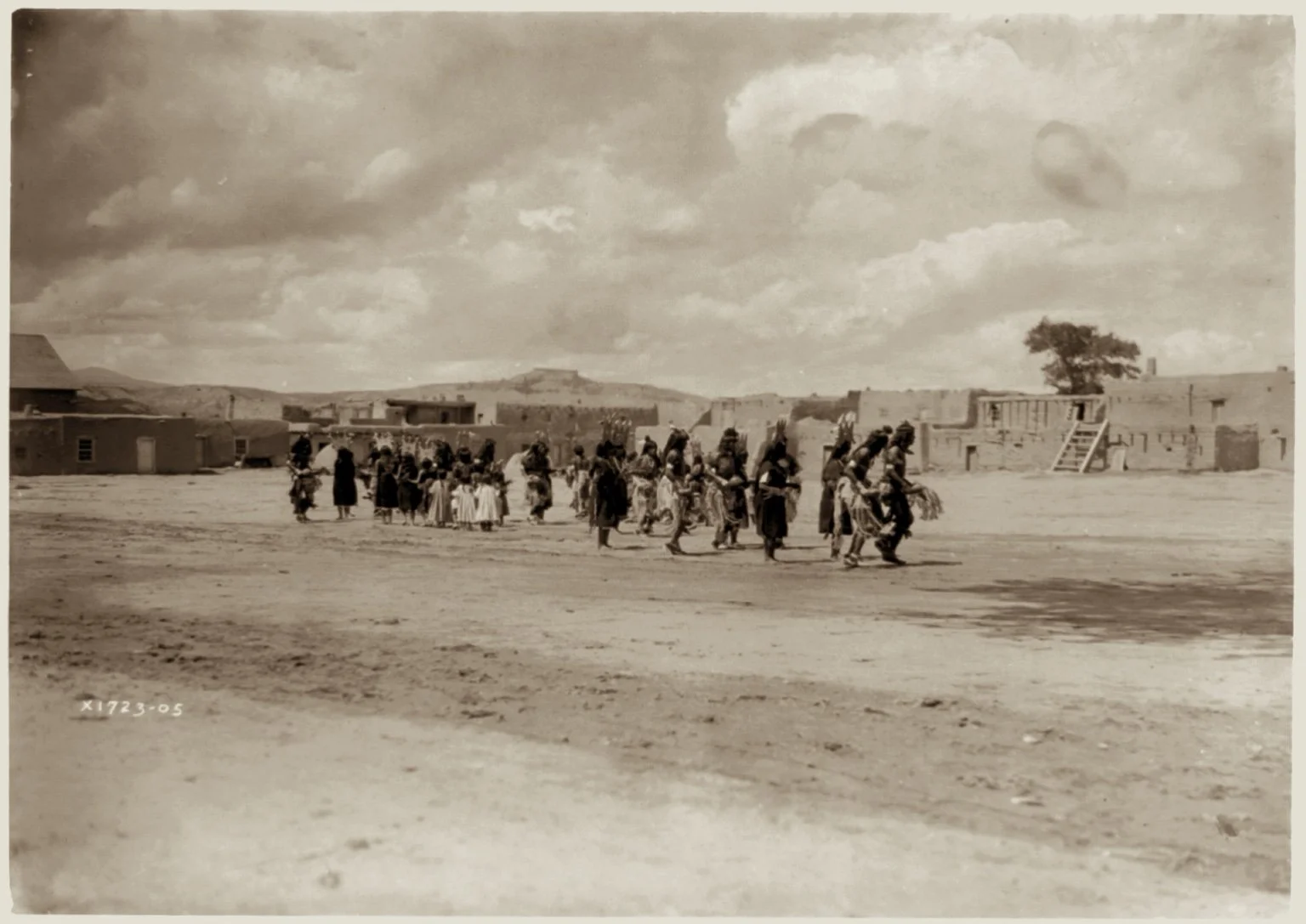STAIRWAY TO HEAVEN
Tablita Woman Dancer San Ildefonso • Circa 1905 • Edward S. Curtis • Image courtesy of the Library of Congress
Hegra, an ancient city in Saudia Arabia, untouched for millennia, recently made its public debut, showing off its Nabataean Crowns, stone carved stairs which rest above the doorway of each sand-worn tomb. And centuries later, under the same stars yet many miles away, these tombs have an uncanny resemblance to the steps decorating the Tablita headdresses worn atop the heads of dancing Pueblo women...
Tablita Dance Headdress • The stepped forms at the top are stylized clouds, while the paired feathers may symbolize prayers • Rio Grande Pueblo • Circa Early 1900’s • The Cleveland Museum of Art, Cleveland
The Archaeological Site of Al-Hijr is the first World Heritage property to be inscribed in Saudi Arabia. Formerly known as Hegra, it is the largest conserved site of the Nabataean Civilization south of Petra, Jordan, dating from the 1st century B.C. to the 1st century A.D. “Hegra contains 111 carefully carved tombs, far fewer than the more than 600 mostly decrepit examples at the Nabataean capital of Petra... Classical Greek and Roman architecture clearly influenced construction, and many tombs include capital-topped columns that hold a triangular pediment above the doorway or a tomb-wide entablature. A Nabataean ‘crown,’ consisting of two sets of five stairs, rests at the uppermost part of the facade, waiting to transport the soul to heaven. Sphinxes, eagles and griffins with spread wings — important symbols in the Greek, Roman, Egyptian and Persian worlds — menacingly hover above the tomb entrances to protect them from intruders. Others are guarded by Medusa-like masks, with snakes spiraling out as hair.” writes Smithsonian Magazine.
The Qasr al-Farid Tomb at Al-Hijr (Mada'en Saleh) • Hegra Archaeological Site • 1st Century B.C. - 1st Century A.D. • Nabataean Civilization • Saudia Arabia
Tablita Woman Dancer San Ildefonso • Circa 1905 • Edward S. Curtis • Image courtesy of the Library of Congress
Tablita Dance Headdress • The stepped forms at the top are stylized clouds, while the paired feathers may symbolize prayers • Rio Grande Pueblo • Circa Early 1900’s • The Cleveland Museum of Art, Cleveland
Tomb at Al-Hijr (Mada'en Saleh) • Hegra Archaeological Site • 1st Century B.C. - 1st Century A.D. • Nabataean Civilization • Saudia Arabia
Tablita Dance Headdress • Rio Grande Pueblo • Circa 1875 • The Nelson - Atkins Museum of Art, Kansas City
Tabla Dance San Felipe • Circa 1915 • Horace Swartley • Image courtesy of the Denver Public Library Special Collections
Tombs at Al-Hijr (Mada'en Saleh) • Hegra Archaeological Site • 1st Century B.C. - 1st Century A.D. • Nabataean Civilization • Saudia Arabia
Tablita Headdress Worn by Women of the Squash • San Ildefonso Pueblo • Circa 1860 - 1880 • Image courtesy of the National Museum of the American Indian, Washington D.C.
Tombs at Al-Hijr (Mada'en Saleh) • Hegra Archaeological Site • 1st Century B.C. - 1st Century A.D. • Nabataean Civilization • Saudia Arabia
Tablita Dance San Ildefonso • Circa 1925 • Edward S. Curtis • Image courtesy of Santa Fe Art Auction
The Qasr al-Farid Tomb at Al-Hijr (Mada'en Saleh) • Hegra Archaeological Site • 1st Century B.C. - 1st Century A.D. • Nabataean Civilization • Saudia Arabia
Wood Tablita Headdress • The blue-painted front surfaces bear an abstract representation of weather including red, white, and yellow clouds with black rain beneath and red bolts of lightning projecting from the outermost peripheries • Santo Domingo Pueblo • Circa Late 19th Century • Image courtesy of Artemis Gallery
Tablita Dancers at the Kiva San Ildefonso • Circa 1925 • Edward S. Curtis • Image courtesy of The Museum of Fine Arts, Houston
The Kiva Stairs San Ildefonso • Circa 1925 • Edward S. Curtis • Image courtesy of The J. Paul Getty Museum, Los Angeles
Tombs at Al-Hijr (Mada'en Saleh) • Hegra Archaeological Site • 1st Century B.C. - 1st Century A.D. • Nabataean Civilization • Saudia Arabia
Corn Dance Tabla • Circa 1915 • Horace Swartley • Image courtesy of the Denver Public Library Special Collections
Tomb at Al-Hijr (Mada'en Saleh) • Hegra Archaeological Site • 1st Century B.C. - 1st Century A.D. • Nabataean Civilization • Saudia Arabia
Fiesta de San Esteban, Acoma, New Mexico • Circa 1880 - 1890 • George Wharton James • Amon Carter Museum of American Art, Fort Worth
Silver Tablita ring by contemporary Jemez Pueblo artist Glenda Loretto • 2013 • Shiprock, Santa Fe
Indian "Tablet Dance" at Santo Domingo, New Mexico • June 7, 1890 • Henry François Farny • Denver Public Library Special Collections
Wood & Leather Tablita Headdress • The top of the structure features two red arrows representing lightning and the turquoise and black motifs at the center are meant to evoke clouds. The rest of the face centers around the sun with symbols of corn stalks and hourglass-shaped forms that represent solar energy • Santo Domingo Pueblo • Circa Mid 20th Century • Image courtesy of Artemis Gallery
Tablita Dance San Ildefonso • Circa 1905 • Edward S. Curtis • The Museum of Fine Arts, Houston
Tablita Dance San Ildefonso • Circa 1905 • Edward S. Curtis • Image courtesy of the Library of Congress
Tomb of Lihyan Son of Kuza • Hegra Archaeological Site • 1st Century B.C. - 1st Century A.D. • Nabataean Civilization • Saudia Arabia • Image courtesy of Zuzana Grezingerova


























